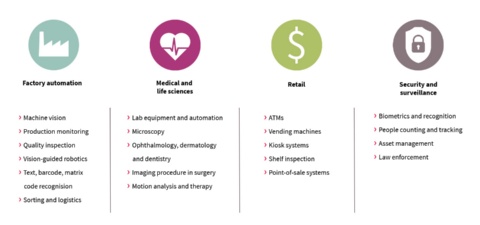EZ-USB™ SX3 FIFO to USB 5 Gbps Peripheral Controller
USB 5Gbps easily configured for UVC/UAC or USB3 Vision applications
Infineon's EZ-USB™ SX3 can be configured with an easy-to-use graphic user interface (GUI), which can customize VID/PID, product strings, serial numbers, FIFO settings, GPIOs, USB endpoints and auxiliary interface. The utility can also create spec-compliant USB Video Class (UVC) and USB Audio Class (UAC) configurations without firmware development, significantly reducing the time-to-market.
Infineon also offers a rich portfolio of USB Type-C port controllers that can be used with the EZ-USB™ SX3 to add USB-C and USB Power Delivery features to cameras, video capturing, or other data acquisition applications.
- Integrated USB 5Gbps PHY
- Supports UAC, UVC, & USB protocols
- Slave FIFO
- Parallel camera interface
- 200 MHz ARM926EJ-S core
- Connectivity to I2C and SPI
- 10 mm x 10 mm, 121-BGA package
- Lowest total cost (bandwidth per dollar) solution for any high-speed system
- Quick time-to-market with low development costs
- Turn-key solutions on industrial standards
Infineon's EZ-USB™ SX3 can be configured for VID/PID, product strings, serial numbers, FIFO settings, GPIOs, USB endpoints and auxiliary interface with easy-to-use graphic user interface (GUI). The utility can also create spec-compliant USB Video Class (UVC) and USB Audio Class (UAC) configurations without firmware development, significantly reducing time to market. In addition to the configurable parameters, developers can also utilize the integrated 32-bit ARM9 processor to perform other tasks and create applications that can differentiate in the market.

USB 3.2 can be beneficial in many different industries such as factory automation, medical and life sciences, retail, and security and surveillance.
Within factory automation, it can be employed in machine vision, production monitoring, quality inspection, vision-guided robotics, text/barcode recognition, sorting and logistics.
In medical and life sciences it can be used in lab equipment and automation, microscopy, ophthalmology, dermatology, dentistry, 3D scanners for prosthesis creation, imaging procedures in surgery, and motion analysis and therapy.
In retail, USB 3.2 (formerly known as "superspeed USB") can be used in ATMs, vending machines, kiosk systems, shelf inspection, and point-of-sales systems.
In security and surveillance, it can then be employed in biometrics and recognition, people counting and tracking, asset management and law enforcement.
Machine vision for industrial automation is a big and diverse market that has enjoyed double-digit annual growth in the past 10 years. With increasing sophistication of machine learning and the abundance of high-speed cameras, machine vision is expected to continue its growth trajectory in the next 10 years, touching even more applications and industries.
USB 3.2 is the heart of machine vision, ensuring flawless imagining and video streaming from 5 Gbps onwards while at the same time proving power-over-cable convenience, plug-and-play simplicity, and software interoperability.
Infineon´s family of EZ-USB™ peripheral controllers offers the most comprehensive USB product portfolio in the industry. Since 1996, it has led the industry by advancing features and performances in programmable USB peripheral controllers, allowing developers to create USB devices to meet the highest performance demands.
More importantly, Infineon’s premium customer support and long-term supply ensure that successful product lifecycles go beyond tens of years. EZ-USB™ portfolio offers the lowest total cost (bandwidth per dollar) solution for any high-speed system, shortens the time to market, and lowers the development costs by offering a turnkey solution including software and several design guides and documents, for commercial and industrial applications.
Since its introduction, USB has developed very quickly, evolving from the original 1.0 to the 2.0 by increasing by 40 times the data rate. With the continual push for higher speed came USB 3.0, which offered yet another 10x speed increase, reaching 5 Gbps.
High-capacity hard disk drives and high-speed cameras started taking advantage of the high data rate and made USB the go-to interface for storage, video streaming, and data acquisition applications. Since then, the USB bandwidth has been doubling every 4 years – from 5 Gbps to 10 Gbps, and then to 20 Gbps – keeping pace with the insatiable appetite for speed from the most demanding applications.






